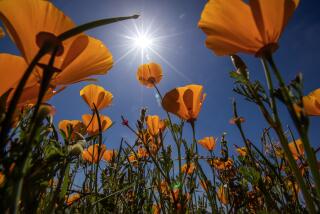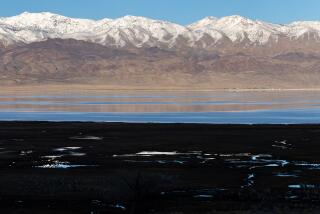Drought a drain on flora, fauna
Around this time each year, thousands make the pilgrimage to the Antelope Valley to see California poppies shining in the fields around Anne Aldrich’s Lancaster home.
“There are fields of orange, just like in ‘The Wizard of Oz’ when you first spot the Emerald City,” Aldrich said.
But not in 2007, as Southern California is poised to experience its driest year on record.
“We don’t have poppies this year. This is about the worst we’ve seen,” she said. “It’s desert-brown.”
The relentlessly dry weather has made this a spring like no other across the region, wreaking havoc on the ecosystem.
Downtown Los Angeles has recorded less than 4 inches of rain since July 1 -- less than a quarter of normal. The region was hit Monday with another round of high heat, low humidity and dry winds, prompting officials to issue a red flag warning for brush fires. (It will continue through tonight.)
The effects of the prolonged dryness can be seen and felt all around. Seasonal ponds are cracked dry, leaving no haven for some frog eggs or fairy shrimp to hatch. Some flower-dependent butterflies are staying dormant for another season.
Plants aren’t bearing berries; some oak trees aren’t sprouting acorns. Bees are behaving strangely.
The problem is apparent in Ventura County, where ranchers are selling their cattle early or thinking about moving them to other states. Ranchers’ lands, starved of rainwater, have not grown the natural grasses key to feeding cattle through the spring and summer.
John Harvey, a Ventura County ranch owner for 30 years, said he will have to sell half his herd of 350 mother cows by summer.
“This is the worst year I can ever remember,” said Harvey, president of the Ventura County Cattlemen’s Assn.
A nature hike through the parched hills of Griffith Park offers few of the usual spring blooms.
“Look at how miserable they are, these seeds,” said longtime ranger Giuseppe Pira, pointing to the shriveled berries of a California toyon shrub, which normally should be plump and green in the spring.
Many of the plants in the park show signs of stress. Leaves droop and seed pods are wilted. Even if a shrub’s leaves are green, they are brittle to the touch.
Because there has been so little rain, Pira said, dust is sticking to the leaves, giving them a sickly look and making plants more susceptible to disease.
“This is entirely different in my years of experience, no flowers, no nothing,” Pira said. “Even the bees -- they don’t have much to eat.”
Fewer flowers means a poor honey season for California beekeepers, who rely on wildflower nectar to feed their bees.
“It looks like we’re going to have one of the worst years for honey production in Southern California,” said Red Bennett, owner of Bennett’s Honey Farm in Fillmore. “Wildflowers represent about 90% of our honey production.”
During the near-record rainy season two years ago, Bennett’s farm produced 2.3 million pounds of honey. He said he expects to produce “40,000 to 50,000 pounds this year, if that.”
“I think that’s optimistic,” said Bennett, who is buying expensive sugar syrup to keep his bee population alive this year.
“We’re kind of like in the Oklahoma Dust Bowl right now,” Bennett said. “There’s nothing we can do about the weather. We don’t cry about it. Our bankers cry a little bit when they don’t get paid.”
In urban areas, bees are becoming more of a nuisance as they try to find additional sources of water. Los Angeles County agricultural officials have detected a spike in complaints about beehives in buildings. There was even a report of a swarm forming inside a sidewalk water main in Highland Park.
“Once natural sources of water in the hills or mountains are dried up, there’s so many backyard swimming pools and people watering their lawns, forming puddles -- it’s attractive,” said Ken Pellman, spokesman for the agricultural commissioner.
The dry weather has resulted in more fires that have been harder to extinguish this winter and spring. A study of moisture levels of plants like sagebrush across Los Angeles County found that they have half the water content this month that they had in May 2006.
Unless there is significant deluge in the next few weeks, which is unlikely, L.A. will set a dryness record this year.
Lush, irrigated lawns and gardens are also attractive for wildlife. That has prompted the Santa Monica Mountains Conservancy to warn that animals such as deer and rabbits might be tempted to look for succulent vegetation in neighborhoods -- and their predators might not be far behind.
“It’s going to be a pretty desperate year,” said Paul Edelman, chief of natural resources and planning at the conservancy.
A resident of La Canada Flintridge reported to the Theodore Payne Foundation, a native plant center, what she considered to be an extremely rare sight: deer roaming around her subdivision, eating ivy.
Elsewhere in the hillside community, Kitty Petti said she saw a bobcat staring at her as she was unloading items from her car April 10 -- the first time she has seen one since she moved into her home 11 years ago.
“The part I found disconcerting was it didn’t head for the hills. It went behind my neighbor’s house,” said the mother of two.
The heat also has Southern Pacific rattlesnakes slithering down from the hills -- and into backyards and even homes.
Snake wrangler Bo Sylapich said he is getting three times the normal business for May. He recently was called to actress Sally Field’s Malibu home, where her gardener was bitten by a snake.
The heat, Sylapich said, has awakened snakes from their winter slumber, and as their prey -- mostly rodents -- search for water, the snakes tag along, taking them closer to water sources.
“Temperatures control their movements,” he said. “They’re just like we are. When we go into air conditioning, they’re looking for air conditioning too. When we come out, they come out.”
Vegetation is parched in forests, and in some spots there will be less surface water for coyotes, bears and mountain lions to drink from, said Stanton Florea, fire information officer for Angeles National Forest.
“There’s not enough green forage,” said Steve Loe, a forest biologist for San Bernardino National Forest.
Though Southern California saw near-record rainfall in 2005, officials are quick to point out it was an aberration. For much of the last decade, the region has experience drought-like conditions, with less rainfall than normal.
The lack of rain has long been a concern as the wild turkey population has dwindled in the San Bernardino forest. Loe worries the turkeys will be particularly hard-hit this year.
Sylapich is concerned, but he’s also philosophical.
“Mother Nature’s having fun with us.”
Times staff writer Amanda Covarrubias contributed to this report.
More to Read
Sign up for The Wild
We’ll help you find the best places to hike, bike and run, as well as the perfect silent spots for meditation and yoga.
You may occasionally receive promotional content from the Los Angeles Times.







